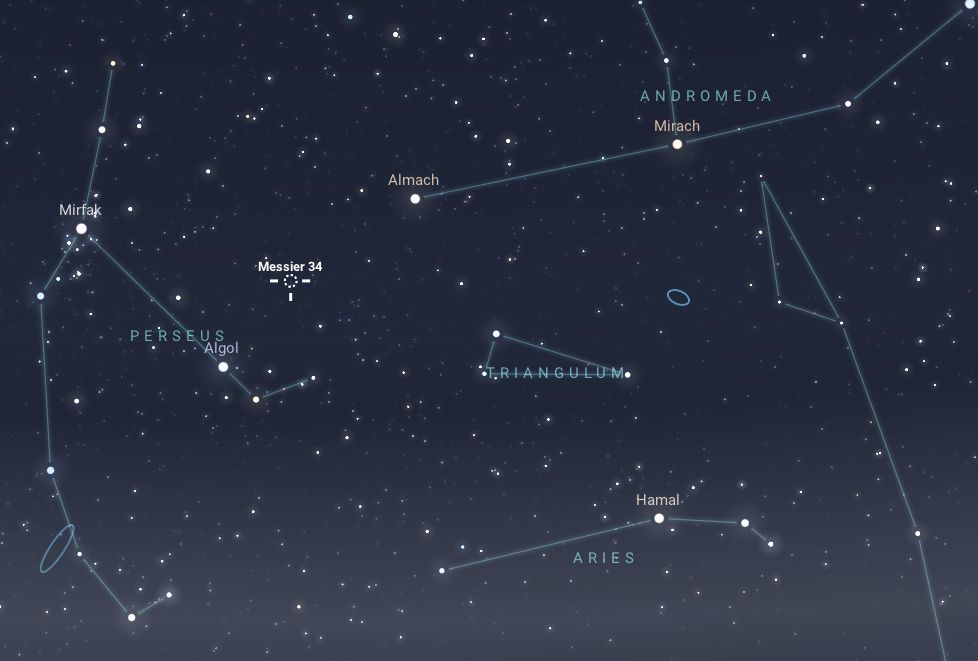M34, also known as NGC 1039, is an open star cluster located in the northern constellation Perseus. It is sometimes called the “Spiral Cluster” because its stars are arranged in a pattern that appears slightly spiral-shaped from our vantage point on Earth. The cluster lies at a distance of approximately 1,500 to 1,800 light-years away, making it relatively close in astronomical terms and providing an excellent object of study for understanding star formation and evolution.
Discovery and History
M34 was first discovered by the Italian astronomer Giovanni Battista Hodierna around 1654, making it one of the earlier star clusters catalogued in European astronomy. However, it was later independently catalogued by Charles Messier in 1764 as part of his effort to identify objects that could be mistaken for comets. Messier’s catalogue entry helped establish M34’s importance in the field of observational astronomy and popularized it as a target for amateur astronomers.
Features and Composition
M34 is a relatively large and rich open cluster containing several hundred stars spread across a distinct spiral-shaped arrangement. Most of its stars are relatively young, with an estimated age of about 100 to 200 million years. This young age means that many of the stars in M34 are still in early stages of their stellar evolution. The stars are thought to have originated from the same giant molecular cloud, sharing a common chemical composition and moving through space together, albeit loosely bound by gravity.
M34 contains a mix of main-sequence stars and some evolving into later stages of stellar life. The brightest stars are typically blue and white, indicating their higher temperatures and younger ages. Additionally, the cluster contains a few yellow stars, which are further along in their evolution compared to their blue counterparts. Its stellar population includes stars similar to our Sun in mass and composition, but they are generally younger, providing valuable clues about stellar aging processes and the early environments of star clusters.

As its stars are loosely bound by gravity, M34 may eventually disperse as individual stars drift away due to gravitational interactions, a common fate for open clusters. Astronomers study clusters like M34 to understand how such groups change over time and how they contribute to the broader stellar population of the Milky Way.
Size and Apparent Magnitude
With an apparent magnitude of around 5.5, M34 is visible to the naked eye under dark sky conditions, though binoculars or a telescope are recommended for a clearer view. The cluster has an angular size of about 35 arcminutes—slightly larger than the full Moon—making it a visually impressive object. The cluster’s stars are spread over a region roughly 14 light-years across, though this spread is not densely packed like a globular cluster, allowing individual stars to be resolved more easily at higher magnifications.
Observation
Located in the constellation Perseus, M34 is best viewed from the Northern Hemisphere, particularly from September to February, when Perseus is high in the night sky. During these months, the constellation rises early in the evening and remains visible for extended periods, making autumn and early winter ideal times to observe it. For those observing with binoculars or a small telescope, M34 appears as a compact but rich collection of stars. A small telescope will allow individual stars to be resolved within the cluster, enhancing its unique spiral-like shape and providing a more detailed view.

Under dark skies, M34 can be spotted with the unaided eye as a faint, nebulous patch, though binoculars or a telescope reveal its starry nature. Using medium to high magnification, observers can separate individual stars within the cluster, offering a clearer view of its overall shape and density. Because of its relatively bright magnitude, M34 remains visible even in suburban skies with moderate light pollution, though darker locations bring out finer details in the cluster’s structure.



